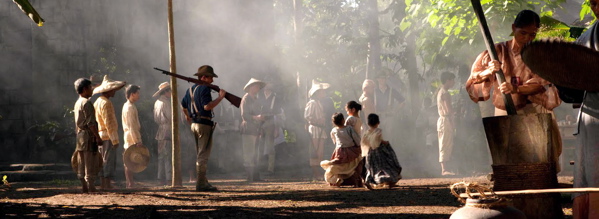By Ray Bennett
TORONTO – John Sayles’s “Amigo” is set during the U.S. incursion in the Philippines in 1900 but the parallels with Afghanistan and Iraq today are clear. It’s an impressive film, but the indie filmmaker has little to add to the debate beyond the eternal truth that the innocent always suffer most.
Good looking, atmospheric and steeped in the culture of the rural Philippines of the time, “Amigo” follows what happens when an American platoon occupies the village of San Isidro deep in the rice paddies far from Manila.
It’s a familiar tale but the setting is different and Sayles tells it with his usual cinematic vigor and attention to small detail. It will appeal to audiences interested in well-told history, and the film should be of great interest to educators as a way of imparting the everlasting tragedy of such conflicts. With much of the dialogue in Spanish, it also should travel well.
With Spain and the U.S. at war, the Philippines declared itself an independent republic in 1989. American troops moved in and the conflict in the Philippines lasted longer than the Spanish-American War.
When Lieutenant Compton (Garret Dillahunt) marches into the village of San Isidro, most of the young men have already joined the rebels. Village headman Rafael (Joel Torre) has incarcerated the remaining Spaniards including Padre Hildago (Yul Vazquez) and declares himself a friend, an amigo, to the invaders.
Rafael’s brother Simon (Ronnie Lazaro), however, is leader of the local rebels and his son has run off to join them. Strict but compassionate, Compton strives to win the hearts and minds of the villagers even as the conflict escalates elsewhere.
When the rebels across the country prove intransigent, U.S. leaders dictate a change from carrot to stick and Compton’s senior office, Colonel Hardacre (Chris Cooper) orders the lieutenant to make war.
Cattle are slain, fields ruined and curfews imposed. Anyone who helps the rebels will be shot. Meanwhile, the rebels issue their own demands that mean anyone who aids the enemy also will be executed. Just like the locals in Afghanistan and many other places, the villagers are caught between a rock and a hard place.
Sayles depicts the young American soldiers as a rough and tender mix with most having learned to demonize the enemy even as the Filipinos they meet turn out to be friendly and cooperative. Tension mounts as the rebels gear up their attacks, violence increases, and the village leader is caught between conflicting obligations.
Dillahunt (“Terminator: The Sarah Connor Chronicles”) makes a strong impression as an officer who is at heart a civilian house builder. He strives for harmony and peacekeeping while following strict orders. Vazquez makes his sanctimonious priest sardonic and merciless, and Torre has an everyman appeal as a leader trying to do the right thing.
Production design by Rodell Cruz makes the most of the sumptuous Philippines locations that make a luxuriant impression in Lee Briones-Meily’s muscular cinematography.
Venue: Toronto International Film Festival; Sales: REZO; Production company: Pinoy Pictures Inc.; Cast: Chris Cooper, Garret Dillahunt, Joel Torre, Yul Vazquez; Director, screenwriter, editor: John Sayles; Producer: Maggie Renzi; Director of photography: Lee Briones-Meily; Production designer: Rodell Cruz; Costume designer: Gino Gonzales; No rating, running time 128 minutes.
This review appears in The Hollywood Reporter

